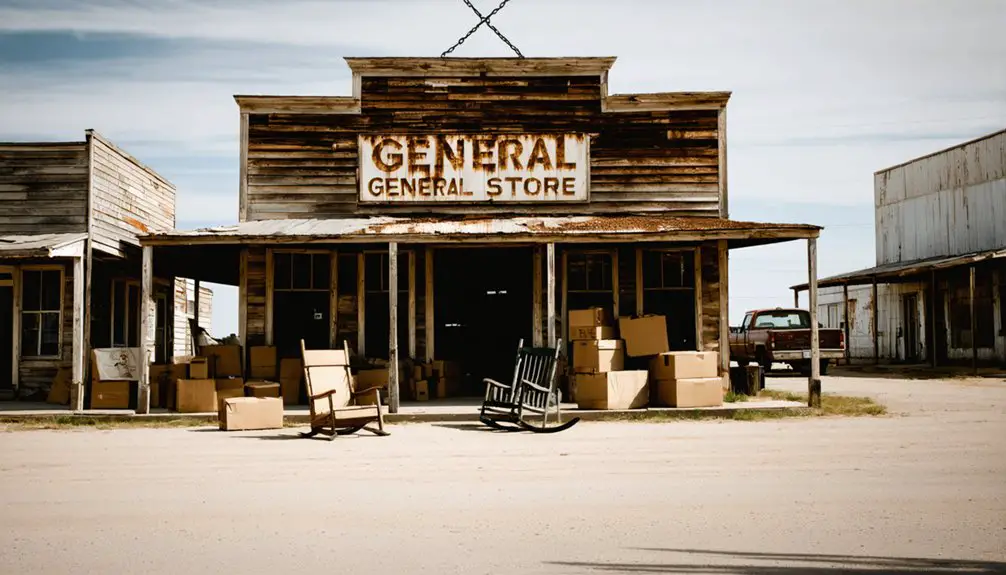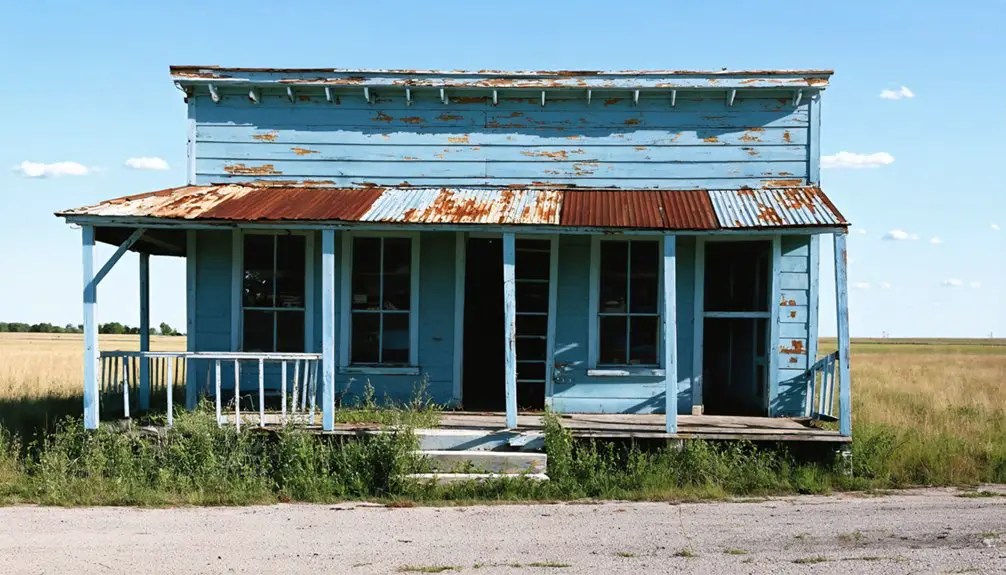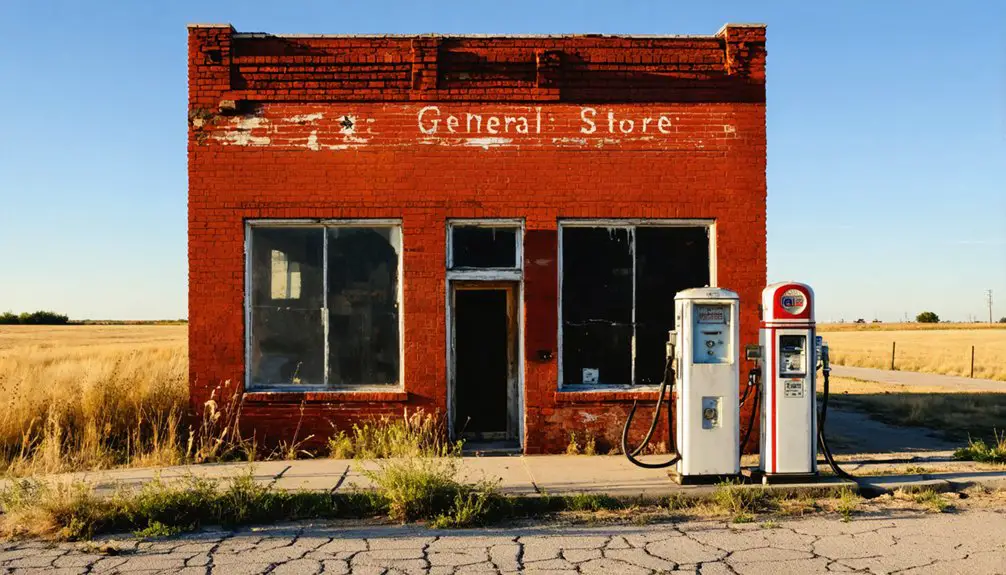You’ll find Picher, Oklahoma’s devastating story written in towering chat piles and empty streets. After lead and zinc discoveries in 1913, the town boomed to 14,000 residents by 1926, supplying over half of America’s wartime metal needs. But toxic mining waste poisoned generations of children, while unstable ground threatened buildings. Today, only six homes remain in this toxic ghost town, where nature’s reclamation reveals the true cost of unchecked industrial growth.
Key Takeaways
- Picher, Oklahoma became a ghost town after extensive lead and zinc mining operations created severe environmental contamination and health hazards.
- The town’s population peaked at 14,000 in 1926 during the mining boom but declined drastically due to toxic contamination.
- Massive chat piles up to 200 feet tall and contaminated groundwater made the area uninhabitable and dangerous.
- A 2008 EF4 tornado, combined with unstable ground from mining operations, led to mandatory evacuations and town abandonment.
- Today, only six homes and one business remain in Picher, surrounded by toxic waste piles and deteriorating infrastructure.
The Mining Boom Years
When lead and zinc ore was discovered on Harry Crawfish’s claim in 1913, the town of Picher quickly emerged as a bustling hub within the Tri-State Mining District. Named after O.S. Picher of the Picher Lead Company, the town’s population exploded to nearly 10,000 by 1920 during the mining boom, reaching over 14,000 residents by 1926. To prevent confusion with other locations sharing the name, the town was officially designated as Picher, Oklahoma.
You’d have found a thriving community where mining operations fueled unprecedented economic growth. The district’s mines supplied more than half of America’s lead and zinc during World War I, generating over $20 billion in ore value between 1917 and 1947.
Over 14,000 miners worked the mines, while 4,000 more supported mining services through 1,500 related businesses. An innovative trolley system connected workers to surrounding towns like Carthage and Joplin, Missouri, creating a dynamic regional workforce. The city was incorporated in March 1918 as the mining industry continued to flourish.
Environmental Impact and Health Crisis
As you visit Fisher today, you’ll see the toxic legacy of its mining past in massive chat piles reaching up to 200 feet tall, continuously releasing hazardous dust containing lead, zinc, and other heavy metals into the surrounding area.
Your heart would break knowing that in 1994, about 35% of local children tested had dangerous blood lead levels exceeding CDC health thresholds, leading to developmental delays, learning disabilities, and other serious health problems.
These poisonous mine tailings, totaling over 70 million tons, have devastated the community’s health for generations while contaminating soil, water, and air throughout the region. The devastating effects were amplified when room and pillar mining created unstable ground conditions beneath the town. The EPA declared the area a Superfund Site in 1983 as contamination reached catastrophic levels.
Toxic Chat Piles Remain
Though Fisher’s mining operations ceased decades ago, the town’s most visible and dangerous legacy remains in the form of massive chat piles – toxic mountains of mine waste that dominate the landscape.
These stark reminders of Oklahoma’s mining past continue to pose serious environmental and health risks to surrounding communities, highlighting the importance of environmental awareness. A 2006 study revealed that 34% of children in the area had dangerously elevated lead levels in their blood. In 2008, an EF4 tornado devastated the area, destroying 150 homes and further accelerating the town’s abandonment.
- You’ll find approximately 178 million tons of contaminated material spread across 30 enormous piles, some reaching heights of 200 feet.
- The toxic legacy includes dangerous metals like lead, zinc, cadmium, and arsenic that contaminate soil and water.
- When winds kick up, toxic dust from these piles spreads freely throughout the region.
- These unstable formations have contributed to ground collapse, making the area increasingly dangerous for visitors and wildlife alike.
Lead Poisoning Claims Children
The devastating impact of lead poisoning has claimed countless young victims in Fisher and surrounding mining communities, with blood screening revealing alarming rates of contamination.
If you’d lived in this former mining area, you’d have faced stark statistics – up to 63% of local children showed dangerous blood lead levels, far exceeding Oklahoma’s 2% state average. Among Native American children, 34% tested above critical thresholds.
You’re looking at a crisis where lead exposure has caused irreversible damage to childhood health. Even at levels below 5 µg/dL, children suffer cognitive impairment and neurological deficits. Early screening and intervention through CDC prevention programs have become crucial for protecting future generations.
The mining waste that blankets the region releases lead dust into soil and household environments, creating an invisible but deadly threat to young residents. The Tar Creek Superfund Site has seen approximately 3,000 properties remediated since 1997 to reduce exposure risks.
Despite intervention programs, the toxic legacy of Fisher’s mining past continues to endanger its children.
Infrastructure Challenges and Safety Concerns
You’ll find Picher’s infrastructure challenges stemmed primarily from the extensive underground mining operations that left 86% of buildings at risk of sudden collapse into abandoned mine shafts.
The room and pillar mining technique created unstable hollow ground conditions, making it increasingly dangerous for residents to remain in their homes.
The combination of toxic mine waste contaminating local utilities and widespread ground subsidence made it impossible to maintain basic services like water, electricity, and safe roadways.
When an EF4 tornado struck in 2008, destroying 150 homes and critical facilities, it delivered the final blow to the town’s already compromised infrastructure, forcing mandatory evacuations.
Mine Collapse Dangers
Living in Fisher faced increasingly dire safety threats as decades of unrestricted mining created a honeycomb of unstable voids beneath the town’s infrastructure.
You couldn’t trust the ground beneath your feet as the Army Corps of Engineers found 86% of buildings were at risk of collapse by 2006. The Krebs mine explosion of 1892 killed 100 miners and highlighted the region’s dangerous mining conditions.
The town’s mining history was marked by devastating accidents and insufficient mine safety measures.
- Methane gas explosions frequently claimed miners’ lives, with the 1912 San Bois disaster killing 73 workers
- Poorly mapped underground tunnels threatened to cave in without warning
- Flooding of abandoned mines created weakly acidic water that further destabilized supports
- Collapse prevention became impossible as the extensive network of tunnels made structural repairs impractical
Toxic Infrastructure Deterioration
During Fisher’s final decades, toxic mine tailings known as chat piles loomed over the town like mountains of poison, reaching heights of 200 feet and perpetually shedding dangerous metal-laden dust into the air.
This toxic legacy created a devastating cycle of infrastructure decay, as lead, zinc, and other heavy metals infiltrated every aspect of daily life.
You’d find the town’s buildings, roads, and utilities crumbling from both above and below. The room-and-pillar mining technique left vast underground voids that threatened to swallow entire structures.
Nearly 86% of buildings, including essential community resources like schools, teetered on the brink of collapse. Sinkholes appeared without warning, while contaminated groundwater corroded foundations and pipes, making even basic infrastructure maintenance a dangerous gamble.
Community Life During Peak Operations
As the mining boom transformed Fisher into a bustling hub of activity, the town’s population swelled to over 14,000 residents by 1926, creating a vibrant community centered around the lead and zinc industries.
You’d find a town pulsing with energy as nearly 20,000 workers moved through the area daily, supporting numerous local businesses and fostering tight-knit social bonds.
- Community gatherings revolved around mining schedules, with social institutions like churches and schools serving as anchors for family life.
- Local merchants catered to both permanent residents and transient workers, creating a dynamic commercial scene.
- Mining companies played a vital role in developing infrastructure, including water wells.
- Local newspapers celebrated the town’s rapid growth, promoting its economic opportunities and potential.
The Evacuation Process

The vibrant community life in Fisher would face an unprecedented challenge as environmental and health concerns forced a systematic evacuation of the entire town.
You’d have witnessed the evacuation timeline unfold gradually through the 1990s, with initial voluntary buyouts meeting resistance from residents who couldn’t bear leaving their homes.
After a devastating EF4 tornado in 2008 destroyed 150 homes, the government response intensified, and mandatory evacuation orders were issued.
Current State and Ghost Town Status
Once vibrant streets now stand eerily silent in Fisher, where toxic chat piles and deteriorating structures tell the story of a town’s forced abandonment.
Today’s ghost town bears little resemblance to its former self, with current conditions reflecting decades of environmental devastation and structural decay.
- You’ll find just six homes and one business standing among the vast emptiness, with most buildings demolished by 2011.
- The landscape remains dominated by massive chat piles and dead vegetation, creating an apocalyptic atmosphere.
- You can spot remnants of community life through deteriorating signs, including the red gorilla mascot base.
- The Quapaw Marshal’s Office survives as one of the few remaining structures, though “Keep Out!” signs warn against trespassing.
The devastating transformation continues as nature slowly reclaims this contaminated ground, leaving only memories of the once-thriving community.
Lessons From a Lost Town

From Fisher’s dramatic rise and fall, modern communities can glean crucial lessons about sustainable development and environmental stewardship.
You’ll see how dependence on a single industry created severe economic vulnerability – the town’s $20 billion mining boom quickly gave way to devastating decline when the resources were depleted.
Without proper environmental oversight, toxic mining waste poisoned the soil, water, and residents, particularly harming children’s development.
The lack of long-term planning undermined community resilience, as underground mines prevented redevelopment and infrastructure couldn’t support economic diversification.
Most telling was how the combination of environmental hazards, health risks, and natural disasters ultimately forced the town’s abandonment.
Frequently Asked Questions
How Much Did Typical Miners Earn During Picher’s Peak Mining Years?
While exact mining wages aren’t documented, you’d have earned enough for a modest living during Picher’s 1920s peak, with the economic impact supporting over 14,000 workers through dangerous 10-12 hour daily shifts.
Were There Any Successful Lawsuits Against Mining Companies for Environmental Damage?
You won’t find well-documented legal precedents showing successful lawsuits against mining companies in Picher. Instead of litigation, the EPA handled environmental damage through mining regulations and Superfund site designation.
What Happened to the Town’s Historical Records and Important Documents?
You’ll find most of Picher’s official records are missing archives now, scattered during evacuation and the 2008 tornado. Without proper historical preservation efforts, documents were lost, destroyed, or dispersed among former residents.
Did Any Businesses or Industries Attempt to Relocate to Picher Post-Mining?
You’ll find no successful business relocations to Picher after 1967’s mine closures. Environmental hazards, unstable ground, and toxic contamination made it impossible for any industries to establish themselves there.
Are There Any Annual Events or Reunions Organized by Former Residents?
You’ll find former residents gather at nearby Picher’s annual mining reunions rather than Fisher-specific events, joining regional celebrations that honor the broader mining district’s shared heritage and community connections.
References
- https://allthatsinteresting.com/ghost-towns/9
- https://quirkytravelguy.com/visiting-picher-oklahoma-ghost-town-toxic-waste/
- https://www.youtube.com/watch?v=pPB4Bal_mm8
- https://en.wikipedia.org/wiki/Picher
- https://www.youtube.com/watch?v=xg8SpCG-wDg
- https://allthatsinteresting.com/picher-oklahoma
- https://www.thesirenspodcast.com/post/case-files-picher-oklahoma
- https://www.okhistory.org/publications/enc/entry?entry=PI002
- https://www.youtube.com/watch?v=dbLyYkx_Kc4
- https://www.youtube.com/watch?v=WCoabzqxjpw



